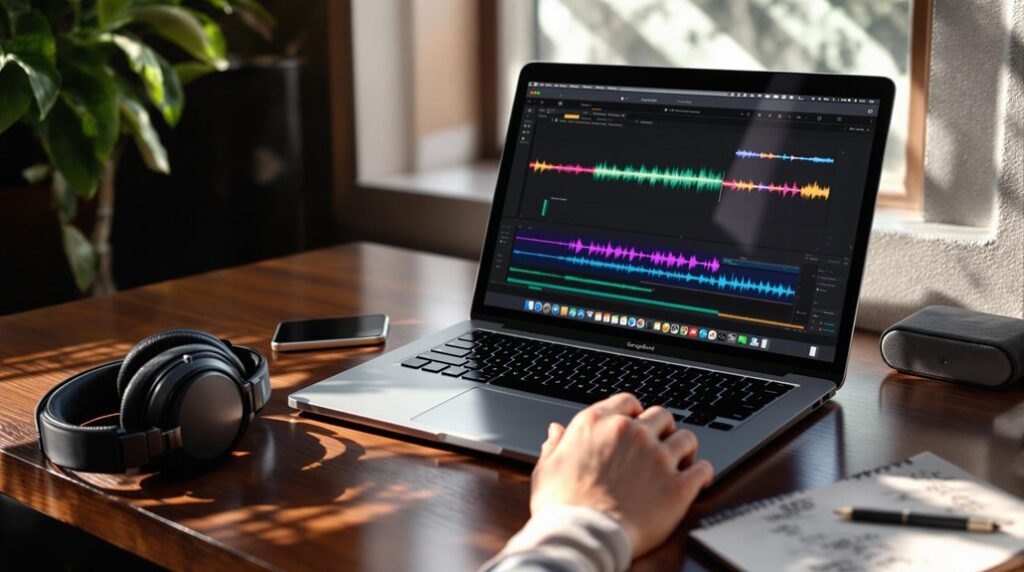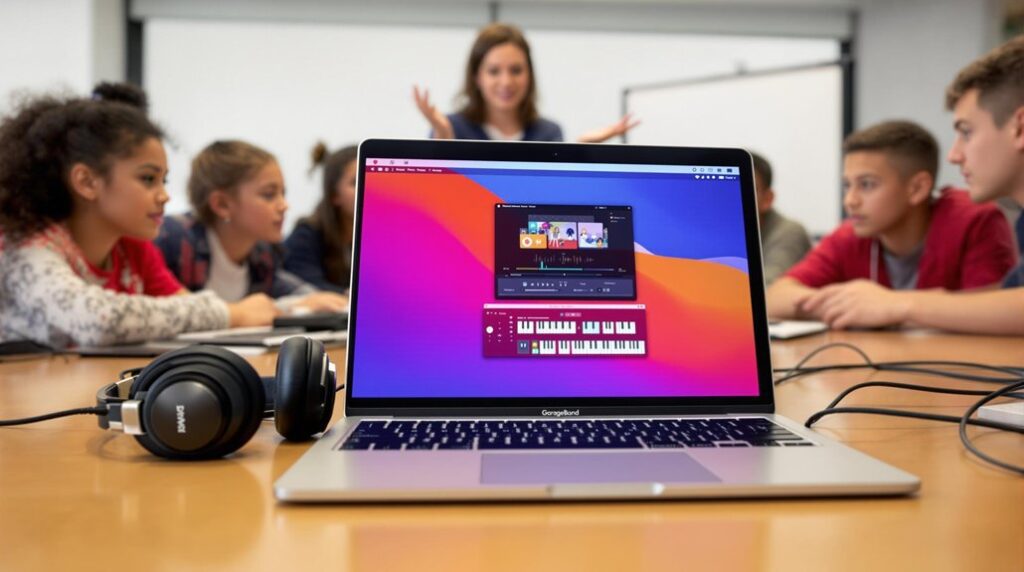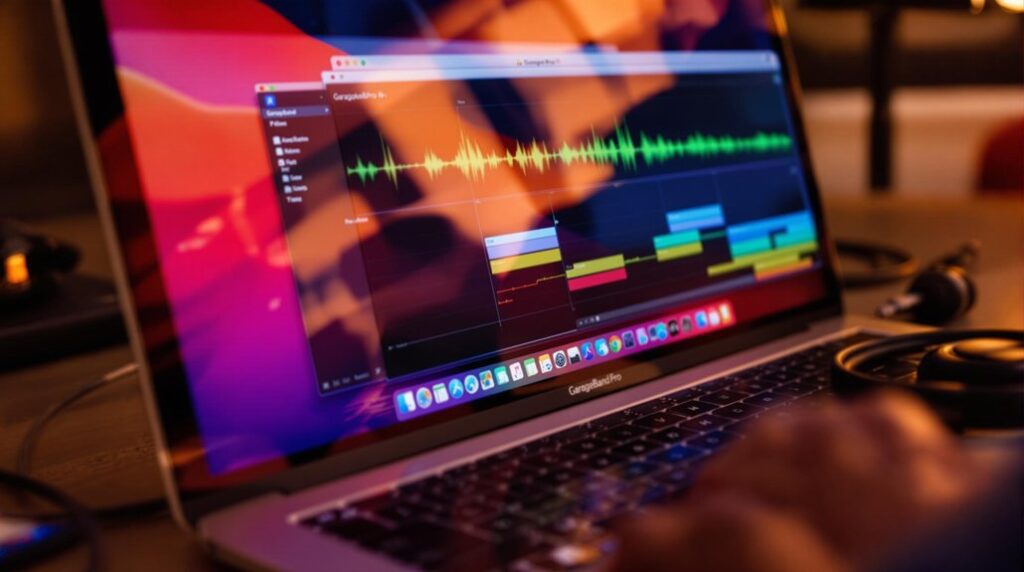Connecting and using MIDI devices with GarageBand requires precise setup and configuration. Begin by attaching your MIDI controller to a Mac via USB for auto-detection, utilizing Audio MIDI Setup for troubleshooting if necessary. For iOS, employ a compatible adapter and enable USB Accessories in settings. Opt for brands like Akai or M-Audio that provide USB or Bluetooth connectivity for peak performance. Troubleshoot connection issues by ensuring track monitoring is enabled and calibration settings are adjusted. Utilize Bluetooth MIDI for a wireless setup and organized workspace. To explore further, continue to advanced insights on enhancing your MIDI integrations with GarageBand.
Key Takeaways
- Connect MIDI devices to Mac via USB or iOS with compatible adapters for seamless GarageBand integration.
- Ensure device recognition in GarageBand by checking connections and troubleshooting via Audio MIDI Setup if needed.
- Choose MIDI controllers with USB or Bluetooth connections for optimal compatibility with GarageBand.
- Enable USB Accessories in iOS settings to allow MIDI communication with GarageBand.
- Use the MIDI Monitor utility to visualize signal flow and troubleshoot connection issues effectively.
Understanding MIDI Devices
MIDI devices, integral components in modern music production, function as sophisticated interfaces between musicians and digital audio workstations (DAWs) like GarageBand. These devices generate MIDI data signals to control various DAW parameters without producing sound themselves. MIDI controllers, including keyboards, drum pads, and control surfaces, connect to GarageBand via standardized protocols to transmit data concerning notes, tempo, and control parameters. This data is interpreted by GarageBand, which then synthesizes sound through its software instruments. The versatility of MIDI devices allows them to adapt to diverse musical styles, enabling intricate compositions and real-time sound manipulation. Their expressiveness and playability offer musicians the capability to craft complex auditory environments, enhancing both production and live performances in a highly dynamic manner. The growing market trend reflects a demand for high-quality mobile music production tools, with portable solutions catering to musicians needing user-friendly music creation tools.
Connecting MIDI Controllers
To establish a robust connection between your MIDI controller and GarageBand, employ a USB cable for Mac systems or the appropriate Apple adapter for iOS devices, ensuring compatibility and secure linkage. For Bluetooth-enabled MIDI controllers, initiate pairing via the device settings before confirming the connection within GarageBand's Bluetooth MIDI devices menu. Velocity-sensitive keys are essential for creating expressive performances, as they respond dynamically to the intensity of your play. In cases of connectivity issues, verify cable integrity, channel alignment, and utilize the Audio MIDI Setup utility for thorough troubleshooting.
USB and Bluetooth Connectivity
Establishing a seamless connection between MIDI controllers and GarageBand requires understanding both USB and Bluetooth connectivity options. For USB, connect a MIDI keyboard using a compatible USB cable or appropriate adapter for iOS devices, ensuring a secure connection for accurate device recognition. For Bluetooth MIDI, enable Bluetooth on your iOS device and connect a compatible Bluetooth MIDI device within the device settings before launching GarageBand. This wireless option supports multiple simultaneous connections, ideal for collaborative environments.
'''markdown
| Connectivity Type | Requirements |
|---|---|
| USB | Compatible USB cable or adapter |
| Bluetooth | Bluetooth-enabled MIDI device |
| Detection | Automatic in GarageBand upon connection |
'''
Upon connection, GarageBand automatically detects MIDI input, facilitating virtual instrument access and performance recording directly into tracks, enhancing creative workflow.
Troubleshooting Connection Issues
Guiding connection issues between your MIDI controller and GarageBand requires a methodical approach to troubleshooting.
Begin by confirming track monitoring is enabled in GarageBand; its absence can inhibit sound output despite proper MIDI connection.
Inspect all cables for damage or loose connections, employing the Audio MIDI Setup application on your Mac to confirm device recognition.
If notes seem stuck, calibrate the note-off velocity sensitivity on your MIDI controller.
Verify that MIDI channels on your controller align with those in GarageBand, as mismatched channels can disrupt communication.
Utilize a MIDI Monitor utility to diagnose signal flow problems, allowing you to visualize whether MIDI data is transmitting correctly from the controller to GarageBand.
This systematic approach confirms effective MIDI connectivity.
Compatible MIDI Options
Selecting the right MIDI controller is paramount for maximizing the capabilities of GarageBand, especially given the multitude of available options.
To guarantee peak performance, choose a MIDI device with a USB connection or a compatible Bluetooth® MIDI device to seamlessly connect your MIDI to GarageBand.
Renowned brands like Akai, Novation, and M-Audio offer robust controllers with customizable controls, enhancing creative workflows.
Prior to acquisition, verify that the controller's hardware specifications align with GarageBand's compatibility requirements.
Testing the MIDI controller in-store is advisable to confirm its seamless integration and functionality with GarageBand.
This hands-on approach ensures you select a device that not only meets technical specifications but also complements your creative process, guaranteeing an efficient and productive music-making experience.
For those prioritizing portability, consider options like the Akai MPK Mini Mk3, which offers a compact and lightweight design while maintaining strong integration with GarageBand.
Mac Connection Steps
With an understanding of compatible MIDI options, the next step involves establishing a seamless connection between your MIDI controller and Mac using GarageBand.
Start by connecting the MIDI device to your Mac via a USB cable, verifying the connection is secure within the USB port. Once the link is established, your Mac should automatically detect the MIDI input.
Open GarageBand to confirm the device is recognized. If the MIDI device fails to appear, navigate to the Audio MIDI Setup utility located in Applications > Utilities for troubleshooting.
It's essential to enable track monitoring within GarageBand to verify audio output from the controller. For peak performance, align the MIDI channels on the device with those configured in GarageBand.
Ios Connection Guide
To connect a MIDI controller to an iOS device, it is crucial to employ either a 30-pin or Lightning to USB Camera Adapter, guaranteeing that the MIDI controller is securely connected to the adapter before linking it to the iOS device. Open the GarageBand app on your iPhone or iPad, navigate to the Smart Instruments tab, and add a software instrument track to verify MIDI recognition. Enable USB Accessories under Face ID & Passcode settings to facilitate connection. If issues arise, confirm track monitoring is enabled and connections are intact. Test the controller in GarageBand for best performance. Consider using MIDI controllers like the Akai MPK Mini to enhance your music production experience with expressive input options.
Bluetooth MIDI Setup
How can you seamlessly integrate Bluetooth MIDI devices with your GarageBand setup?
Begin by verifying Bluetooth is enabled on your device. Pair the Bluetooth MIDI device through the device settings to establish an initial connection.
Once paired, launch GarageBand and navigate to the MIDI settings to select the newly connected Bluetooth MIDI device. Confirm that the connection is successful by checking the GarageBand interface for device recognition indicators.
Optimize performance by adjusting latency settings within GarageBand to minimize delays during playback or recording.
If connectivity issues arise, verify the battery levels of the Bluetooth MIDI device and consider restarting both the MIDI device and your iPhone/iPad.
Ascertain other Bluetooth devices are not causing interference for an uninterrupted experience.
Using MIDI in GarageBand
Harness the full potential of MIDI technology in GarageBand by understanding the seamless integration of MIDI controllers, which act as conduits for transmitting performance data to the software's array of virtual instruments. Begin by creating a software instrument track and selecting an appropriate virtual instrument. Tap Bluetooth MIDI to connect wirelessly, or use a direct connection for any MIDI device with GarageBand. Activate track monitoring to hear real-time output. Post-recording, leverage GarageBand's editing capabilities for fine-tuning velocity sensitivity and note timing. Explore the diverse range of virtual instruments, from synthesizers to keyboards, available at no cost. Additionally, Smart Controls allow you to customize instrument sounds by adjusting parameters such as reverb and EQ, enhancing your creative expression.
| Feature | Description | Benefit |
|---|---|---|
| MIDI Controller | Sends MIDI data signals | Triggers virtual instruments |
| Real-time Editing | Adjusts velocity and timing | Enhances performance accuracy |
| Bluetooth Connection | Wireless integration | Simplifies setup |
| Track Monitoring | Enables sound output while playing | Real-time auditory feedback |
| Virtual Instruments | Free access to various instruments | Expands creative possibilities |
Troubleshooting MIDI Issues
To address sound issues within GarageBand, first verify track monitoring is activated, as its absence can inhibit sound output from the MIDI controller.
For connection failures, meticulously inspect the physical integrity of all cables and connections, and employ the Audio MIDI Setup utility to confirm the system's recognition of the MIDI device.
Additionally, synchronize the MIDI channel settings on both the controller and GarageBand to verify seamless communication and utilize a MIDI Monitor utility to trace and verify the MIDI data transmission path.
Consider using an audio interface with direct monitoring capabilities to minimize latency and ensure the highest audio quality during your recording sessions.
Resolving Sound Issues
Addressing sound issues when connecting MIDI devices to GarageBand requires a methodical approach to ascertain seamless audio performance.
Initially, confirm that track monitoring is enabled within GarageBand, a critical step to audibly monitor MIDI-triggered sounds.
Employ the Audio MIDI Setup utility to verify the MIDI device's recognition by the system, which serves as a foundational check for connectivity.
To further diagnose issues, utilize a MIDI Monitor utility, enabling precise analysis of the signal flow to ascertain correct transmission of MIDI data.
Additionally, verify that MIDI channels are aligned between the controller and GarageBand, as any disparity can obstruct sound triggering.
Finally, adjust note-off velocity sensitivity if encountering stuck notes, ensuring harmonious interaction between the controller and software.
Fixing Connection Failures
When troubleshooting MIDI connection failures with GarageBand, verify all physical connections are secure and functional. Ascertain the MIDI device is properly connected and all USB ports are operational.
Utilize the Audio MIDI Setup utility on your Mac to ascertain recognition and proper functionality of the MIDI device within the system. Confirm MIDI channels on your controller align with those in GarageBand to prevent connectivity issues. Additionally, confirm track monitoring is enabled, as this can impede sound output.
- Confirm cable connections and USB port functionality to avoid connection failures.
- Use Audio MIDI Setup to verify the MIDI device's recognition and operation.
- Align MIDI channels on the controller and GarageBand to ascertain proper connectivity.
If persistent issues arise, restart both the MIDI device and your computer.
Benefits of Bluetooth MIDI
Embracing Bluetooth MIDI technology transforms the musician's workspace by eliminating cumbersome physical cables, thereby fostering a cleaner and more organized environment. This wireless advancement supports low-latency performance, essential for real-time music production and control. Musicians can seamlessly integrate multiple Bluetooth MIDI devices, facilitating collaborative sessions and dynamic performances. The innate portability of Bluetooth MIDI is invaluable for musicians who frequently perform live or are always on the move, ensuring flexibility without compromising performance integrity. In addition, the ability to switch between instruments and devices without re-cabling enhances the creative workflow, fostering an uninterrupted artistic process.
| Feature | Benefit |
|---|---|
| Cable-Free | Organized and clutter-free workspace |
| Low-Latency | Real-time playing and recording |
| Multi-Device Connectivity | Collaborative and dynamic sessions |
| Portability | Ideal for live performances and mobility |
Adapter Recommendations
When integrating MIDI devices with Garageband, selecting high-quality adapters is imperative for ensuring stable data transmission and preventing connectivity disruptions.
For iOS devices, a Lightning to USB adapter is mandatory for pre-2018 models, whereas a USB-C to USB adapter is required for devices from 2018 onwards, with a strong recommendation for adapters that offer charging capabilities to maintain device power.
Verifying adapter specifications for compatibility with various MIDI keyboards is essential, and resources such as product descriptions and online links can guide users in selecting the most suitable and reliable options.
Quality Adapter Options
Selecting the right adapter for connecting MIDI devices to iOS platforms is essential for ideal performance and seamless integration.
For iPhones and pre-2018 iPads, the Lightning to USB Camera Adapter is a highly recommended solution to connect MIDI keyboards, ensuring stable connectivity and charging capability. Quality adapters not only enhance the performance of your setup but also prevent battery drain during extended use.
Ensuring compatibility with your specific MIDI keyboard is vital to avoid connectivity interruptions.
- Lighting to USB Camera Adapter: Suitable for iPhones and pre-2018 iPads.
- USB-C to USB Adapter: Ideal for iPads released in 2018 or later.
- Support for USB Accessories: Enhances functionality across various devices.
Investing in a reliable adapter optimizes your MIDI connection, markedly reducing connectivity issues in music production environments.
Connectivity With Devices
Mastering the connection of MIDI devices to iOS platforms requires selecting the ideal adapter to guarantee seamless integration and functionality.
Employing a Lightning to USB adapter for older models, or a USB-C to USB adapter for 2018 iPads onward, is essential. Opt for adapters with a charging port to mitigate battery depletion, thereby maintaining device performance during extended sessions.
To verify stable data transmission and compatibility, high-quality adapters are recommended. Prior to connection, enable USB Accessories in settings: navigate to Face ID & Passcode (or Touch ID & Passcode).
Upon connection, tap the Connect switch, set the control knob, and open up GarageBand. Immediate recognition should occur, though troubleshooting steps may be required if the MIDI interface is not detected.
Device Settings Configuration
To guarantee seamless integration of your MIDI device with GarageBand, initiate the configuration process by accessing the settings app on your iOS device.
Navigate to the Face ID & Passcode (or Touch ID & Passcode for iPad) section and input your passcode to advance the device settings configuration.
Within the settings, pinpoint and enable the USB Accessories option. This step is pivotal as it guarantees the MIDI keyboard's effective communication with GarageBand.
Additionally, verify that your iOS device's software is updated to the latest version to maintain compatibility with MIDI devices.
- Enable USB Accessories: Verify this option is turned on for successful MIDI connection.
- Software Update: Confirm your iOS device is running the latest software version.
- Security Access: Enter your passcode to modify necessary settings.
Frequently Asked Questions
How to Connect Midi Device to Garageband?
To connect various MIDI device types to GarageBand, utilize appropriate USB adapters and enable relevant GarageBand settings. If issues arise, employ troubleshooting tips such as verifying cable integrity and utilizing the Audio MIDI Setup utility for diagnostics.
How to Connect MIDI Devices Together?
To connect MIDI devices together, verify MIDI device compatibility and utilize appropriate MIDI cable types. Link the MIDI OUT to MIDI IN, maintaining correct MIDI signal flow. For complex setups, consider using a MIDI interface or splitter for efficiency.
Why Is My MIDI Keyboard Not Connecting to Garageband?
To address common connection issues preventing a MIDI keyboard from interfacing with GarageBand, follow a detailed MIDI troubleshooting guide. Confirm proper keyboard setup, verifying secure connections, MIDI recognition, software instrument track creation, and updated firmware.
How to Connect MIDI Controller to Mac?
To connect a MIDI controller to a Mac, utilize USB MIDI connections for seamless integration. Ascertain compatibility with various MIDI controller types. Access "Audio MIDI Setup" for configuration. Verify functionality through MIDI setup tips for peak performance.
Conclusion
The integration of MIDI devices with GarageBand enhances musical production by enabling precise control over digital instruments. Understanding the nuances of MIDI technology and guaranteeing compatibility through proper connection methods is essential. The utilization of Bluetooth MIDI offers increased flexibility, while selecting the appropriate adapters and configuring device settings optimizes performance. Addressing troubleshooting procedures effectively guarantees seamless operation. Mastery of these aspects facilitates an enriched creative process within the digital audio workspace provided by GarageBand.




